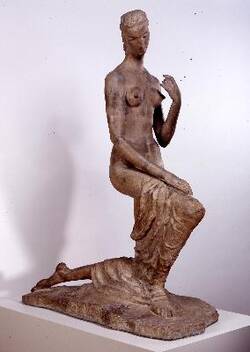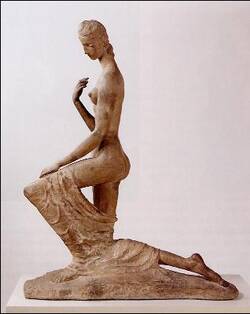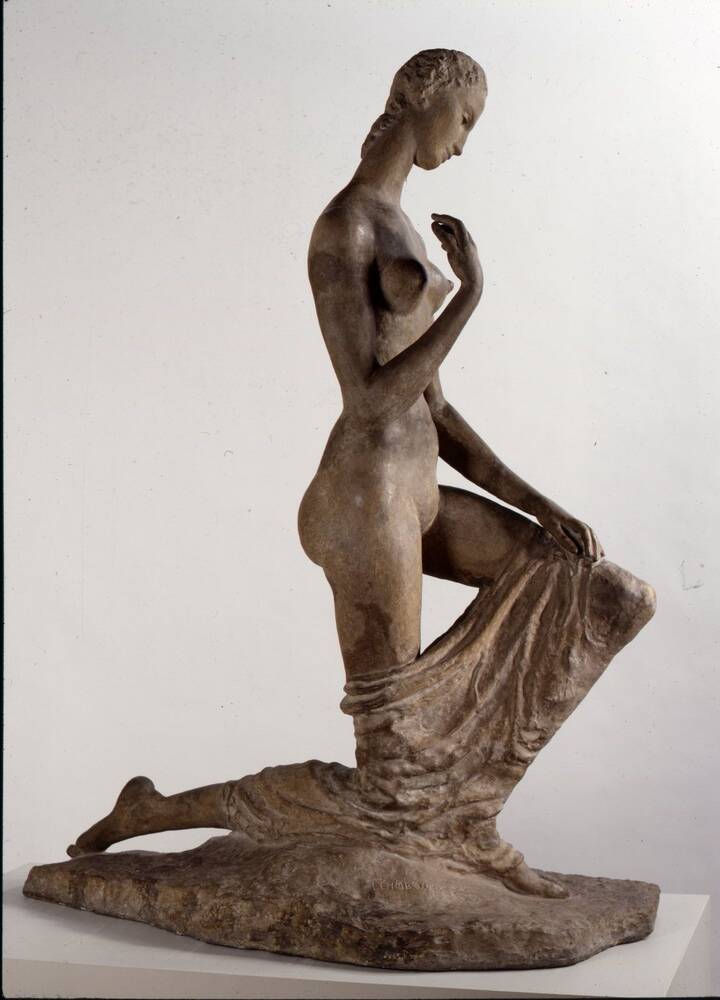Her head is turned to one side, looking down. Her eyes are closed. Her right arm is bent, her hand in front of her breast – almost a gesture of humility. She seems entirely self-absorbed, oblivious of the world around her.
Wilhelm Lehmbruck’s sculpture dates from 1911. At that time he was living in Paris. He had intensively studied works by Auguste Rodin and Aristide Maillol, but was already moving away from their influence to create his own formal vocabulary. Listen to curator Astrid Nielsen on Lehmbruck’s Woman Kneeling:
"If this figure were to stand up, she would be around 222 centimetres – over seven feet tall. So when Lehmbruck first showed this work, it was very controversial. And since the figure’s elongated limbs are miles away from our natural anatomy, they came in for a lot of criticism.”
But Lehmbruck was not interested in a mimetic copy of natural body shapes.
“What is also new here is the idea – already inherent in Rodin – of expressionist sculpture. In other words, these figures only represent themselves and what they want to say.”
Lehmbruck’s Woman Kneeling is not carved in stone, but cast in stone – a technique extremely popular in France at that time. For a stone cast, crushed stone is mixed with water and cement and poured into a negative mould. After hardening, the cast is removed from the mould and finished by hand. The stone cast technique allows numerous copies of a sculpture to be made. The Woman Kneeling on show here was actually cast in 1920, the year after Lehmbruck died. This is the only stone cast Woman Kneeling still in Europe.
Further Media
“Degenerate” Art
On 19 July 1937, the Nazi regime opened the “Degenerate Art” exhibition in Munich. The show presented and defamed 650 modern art works which the Nazis had previously confiscated from museums across Germany. Shortly afterwards, Lehmbruck’s Kneeling Woman fell victim to a second, much larger wave of confiscations. Astrid Nielsen on the events in Dresden:
“In September 1937, various sculptures were also confiscated in Dresden as so-called “degenerate art”. Fewer works were taken than in other museums – for diverse reasons. It might have been due to the director at that time possibly hiding art works or refusing the commissions access to the inventories. In any case, only eleven sculptures were seized from the Dresden collection. The pieces confiscated included, for instance, works by Ernst Barlach, Bernhard Hoetger, and three sculptures by Wilhelm Lehmbruck.”
Lehmbruck’s elongated, expressionist figure of a kneeling woman fundamentally went against the style of art advocated by the Nazi regime:
“The Nazis had a particular notion of art. Of course, in their view art should propagate the Nordic type, a specific physique, an ideal human being – but this does not mean they were blind to the monetary value of other art works.”
The Nazi regime planned to sell the confiscated works to generate foreign currency. So Lehmbruck’s Kneeling Woman was first taken to Berlin and placed in storage in Schönhausen Palace. Afterwards, the cast stone statue was sold to America via the Swiss art market.
“This work passed through several private collections in America. In 1993, it reappeared on the art market. And so over sixty years after the statue was confiscated, it was possible to reacquire it for the SKD’s Sculpture Collection.”
- Location & Dating
- Model 1911, cast after the original form, 1920
- Material & Technique
- Cast stone
- Dimenions
- H: 179,0 cm, B: 68,5 cm, T: 140,0 cm
- Museum
- Skulpturensammlung
- Inventory number
- ZV 2840


